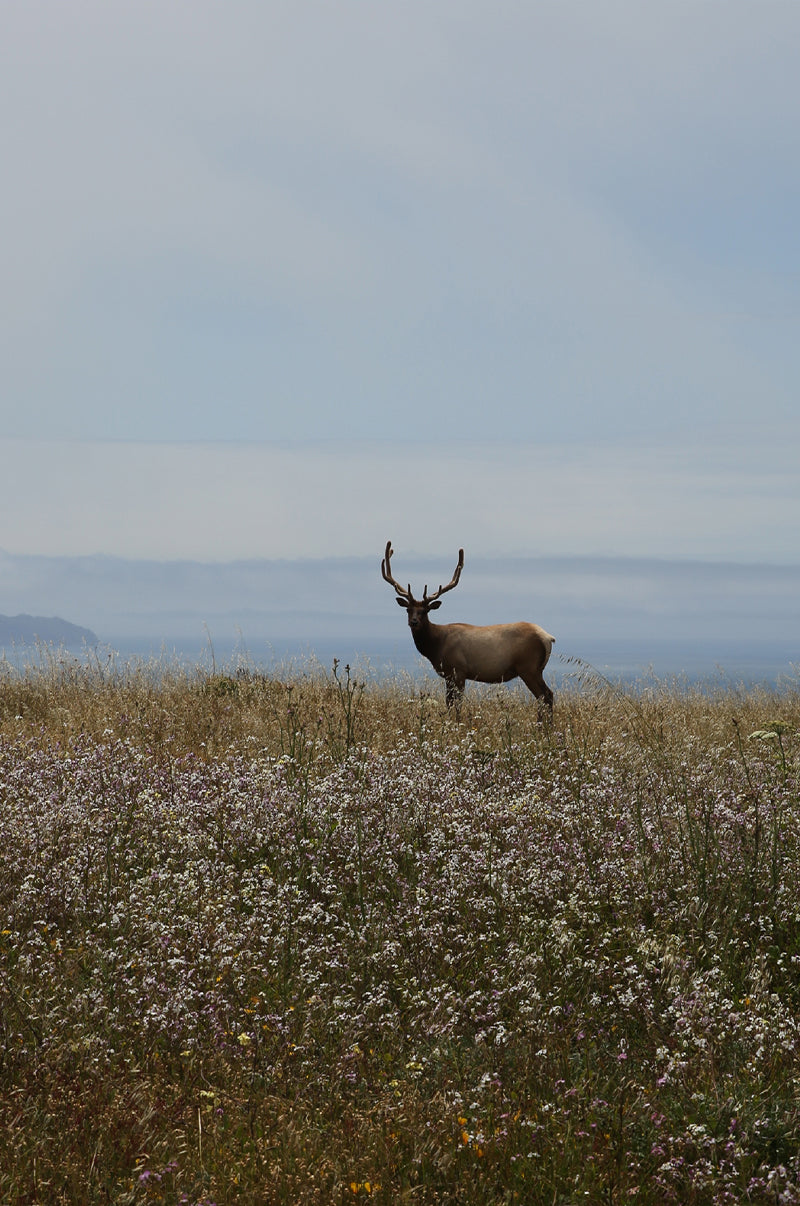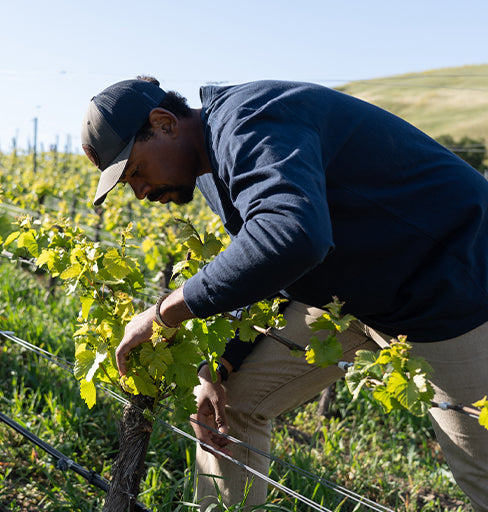Can you share with us your journey to becoming the Director of Land Stewardship at White Buffalo Land Trust and what initially inspired you to pursue a career in this field?
Before WBLT, I worked in graphic design, product design, and industrial design before transitioning to agriculture in 2012. I took an agricultural system design course when I was studying in Europe for a year, and that really shifted my perspective on what the design process could do for living systems and for food systems. This led me to taking part in a farming business with my family and community in 2013 called Regenerative Earth Farms. It was a multi-enterprise farming operation that included an organic cheese creamery perennial orchards, heritage animals, and-integrated diverse herb and veggie production. We grew for local restaurants, regional markets, our farmstand, and did a lot of education and community engagement.
In 2017, the wildfires displaced us from the farm, and the 2018 mudslides in Montecito ripped through our community and disrupted our food system. The loss of life and property shook people, and there was a reassessment of what true food security and food system / community resilience look like. That same year, I met my partner, Steve Finkel, founder and president of the White Buffalo Land Trust. I was the first employee, named Director of Land Stewardship, and we began to grow a team from there.
The team really developed around this theory of change, in that we knew we needed to be direct land stewards with our hands and feet on the ground, continually be engaged in a process of discovery and learning through research and monitoring and produced experiential engagement opportunities through education and training programs. That cyclical model of learn, share, do really follows our fields of focus theory of change..
As the Director of Land Stewardship, what are your primary responsibilities and what does a typical day look like for you?
My primary responsibility is in the land management and design of programming and monitoring at Jalama Canyon Ranch, as well as contributing to the oversight and strategic direction of WBLT. Land stewardship really revolves around our animal integration, pasture rotations, vineyard management, and cover crop regimes, as well as composting protocols, biodiversity, and irrigation decisions—which are made based off of soil monitoring—then related programming around them. We regularly ask ourselves, how do we provide educational opportunities for different groups? How do we communicate our findings through research and monitoring?
I very rarely have a “normal” day, and the likelihood of me having a repeatable schedule is pretty low. I’m split roughly 60/40 between office time and field work time, though that fluctuates by season, of course. In spring, things start kicking, and I’m out in the field a lot more, whereas winter is when a lot of grant writing, reporting, budgeting, and project planning takes place.
What are some of the biggest challenges you face in land stewardship today?
One of our biggest challenges, which is not inherently unique to our land stewardship, is that we are working with a land base whose ecological functionality has been depleted over time. Many facets have declined in terms of functionality and capacity, including loss of nutrients and organic matter in soil, as well as the amount of soil itself. Watershed functionality is also down (depleting aquifers, lower quality water, wells with higher dissolved soils and salt), and there’s an overall loss of biodiversity in terms of predators and insects.
These losses have caused a massive decline in our natural system’s ability to self regulate, so it’s not as easy to use natural methods that harmonize with natural cycles as it might have been a couple of generations ago. Thus, we find ourselves in this push-and-pull, tug of war desire to be aligned with natural systems, while also working with systems that have a declining functionality. Bringing these systems back into a functioning state requires investment, both financial and intellectual, and we have to learn new ways of doing things.
However, there’s a balancing act between what it costs and what the market will pay in order to justify that management, and that’s a big tension in the field right now. People have an inherent knowledge on what is right, though doing so generally impacts their financial bottom line—and that’s fine, as long as the value is compensated appropriately. The complexity of that mechanism is for me the most difficult thing to navigate right now in agriculture. Who benefits from regenerative land stewardship? What is the true value of that stewardship, and whose responsibility is it to pay for that value?
How do you address these challenges?
The approach that we’re taking is multifold, one of which is the documentation of the shifts in interventions that occur in the management of regenerative farming—that is, what are the measurable differences in the land or product that we can begin to track to show the difference in management approach and management outcome. Then, we figure out how to communicate this and deepen a broader caring and understanding.
Through ecological monitoring, we can provide value to environmental production agencies, who can then create new incentives to support ranchers to buy regeneratively farmed crops, and who can help with the cost of transitioning to regenerative farming. That’s where you begin to align values and compensation.
How is managing vineyards different from farming other plots of land? What are some key things you've learned?
There are some really good benefits and some really difficult constraints. The benefit is that managing vineyards is quite celebrated, and the process of doing so, along with the uniqueness of location and climate, is described as terroir, and that terroir is one that is valued in the marketplace. In the grand scheme of agriculture, there’s only a small handful of products that you can trade on and uphold some semblance of valuation around the terroir-driven aspect of production.
However, within the wine business, you're also dealing with a deep history of expectation, and a community of status quo. There's a semblance of “this is how it's supposed to be done,” which doesn’t frequently create a lot of room for flexibility with innovation and experimentation. Additionally, that appreciation of terroir also brings with it the downward pressure constraints from a whole class of sommeliers that will notice if you mess up along the way. There are pins, ratings—there’s not a lot of people tasting heritage grain wheats out there, for example! With wine, we are very much going to be judged on every nuance, and that’s a much different game to be played than with other agricultural products.
What is your vision for the future of land stewardship, and what key changes or advancements do you hope to see in the next decade?
I envision an optimistic outcome of regenerative land stewardship as when those who are looking at their landbases, farms and ranches as an interconnected ecosystem of animals, plants, soils, vegetation diversity, and watershed dynamics become incentivized for the management of that whole living ecosystem for its highest potential by ways of increased accessibility, as well as a deepened appreciation of how that affects the downstream customer in their day-to-day life.
Regenerative farming benefits human health and wellbeing by means of nutrient density, less exposure to toxic chemicals, and also ultimately results in better tasting and better flavored food with higher quality fiber. If we can start to show the case for this type of approach to land stewardship through the lens of what's in it for the customer, then I think there’ll be a much greater link between what is incentivized within the marketplace.
Currently, we’re working with the nutrient density alliance to look at how we calculate nutrient density across different product categories. Nowadays, we’re seeing people with wearable technology on their wrists looking at their bodies’ responses to what they’re eating in real time.
As people start to get more attune to how what they eat impacts their health, they're going to be able to make more informed decisions as to what they put in their bodies, and with those decisions will come a new tier of valuation.
What is your relationship with wine and how does it fit into your lifestyle?
I was very grateful to have grown up in a household that had a healthy relationship with food, alcohol, and celebration. I have consumed wine my entire adult life, but have always done so in the context of culinary pairing and moderation—and being on the production process side of it has given me a whole new appreciation for the diversity of wine-growing regions, grape growing approaches, and winemaking. However, as much as I love red and white wine, my favorite beverage in the world is vermouth! I definitely drink more of it than anyone I know.
How can the community help support initiatives at the White Buffalo Land Trust?
The three most simple ways would be to buy the wine and join the wine club, come out and visit us at the ranch for some of our programming (we have open community field days and educational opportunities) and lastly, as we are a public benefit nonprofit corporation, any kind of contributions and donations go to our research, education, and outreach. We are always grateful for those who have the capacity and willingness to donate.
To learn more about the White Buffalo Land Trust, visit whitebuffalolandtrust.org.

